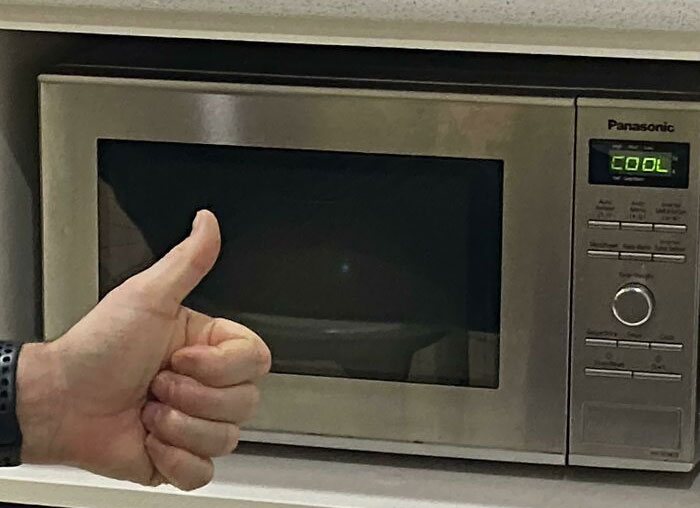deleted by creator
I moved to California last year from Oklahoma. Occasionally I will say something about moving from Oklahoma and people are like, “oh that makes sense, you have a Midwestern accent sometimes”. We all sound normal to ourselves but everyone has an accent. Like the way California people say their O’s.
Midwesterners are the only people I’ve ever met who don’t think they have an accent. And I’m like “you have a midwest accent.” They’re stunned because to them it’s just a “normal” accent, and they know it must be so because it’s what the TV man talks like. Obviously I know midwesterners who know they have an accent and the TV man is trained to speak that way. But everyone else I meet and know knows their own accent and can recognize variations of it. They’re not so conscious of how they make their accent happen, obviously, since it is their own. But they know they sound different from other people
deleted by creator
It’s the “universal English accent” in a sense.
… for American English
deleted by creator
When compared to any accent other than their own.
deleted by creator
I have a hard time understanding the people in a friends village and he lives 50km away
I guess it makes sense. I wouldn’t understand you either from 50km away.
Lemmy: We’re just a bunch of dads
And Linux nerds.
Like the way California people say their O’s
As a Canadian, it’s all I can hear when they speak.
So, I’m from Seattle, basically, and for the longest time I thought no, I do not have an accent.
Then I learned that the reason I thought that was because well, the accent I have is basically the least distinct from the ‘General American English’ or ‘Region Indistinct American’ accent, out of all other regional accents…
With that ‘General American’ accent being what nationwide newscasters, voice actors and movie stars either developed on their own, or were trained into, for being easily intelligible to any other American accent/dialect speaker, or as just sort of a rounded approximation of ‘American’, with no specified regionality to the character.
Thats not to say the PNW or Cali or just general US West accents are all exactly the same as ‘General American’… they are not… its just that they are the least difficult to understand from a general audience perspective out of other regional US accents/dialects… or at least that is the explanation I’ve heard.
As I am aware, the main difference between PNW/Cali English and other US regions is that we have completed the cot-caught merger. Absolutely no difference in pronunciation, the verb sounds are the same… whereas in much of the rest of the US, these are different, distinct vowel sounds. We just use the ‘cot’ pronounciation for both.
Bot cot thot slot thought caught fraught not spot dot.
All the same. No rolling or bending of the first vowel into the u to make a more complex vowel sound, all just ‘bot’ or ‘dot’.
That and pop vs soda vs coke.
For whatever reason, I usually say soda, but that did make me an oddball of most people around me near Seattle saying ‘pop’… but a lot of other places in the US use soda, but also a lot of other places use ‘coke’ to refer to any … soft drink… which confuses and aggrevates my Autistic brain lol.
…
There are a few things that I remember being distinct to Californian accents/dialects as compared to Seattle:
One is the rising tone at the end of the sentence… thing.
I always called this a valley girl accent, and this is because no one I knew as a kid spoke that way… unless their family had recently moved north, from Cali.
Now though, it is more common generally in the PNW, at least in my own experience… but also that could literally be because a lot of Californians have migrated north.
Another silly, but super easy tell someone isn’t from Seattle: Their accent may be essentially indistinguishable from a PNW accent… but they always, always refer to I-5, as ‘the 5’… instead of ‘eye-five’.
No one born and raised near Seattle does this.
I-5 is the main highway that goes all the way down from Vancouver BC, through Seattle, Portland, San Fran, LA, and runs through all of those cities, so its a major reference point of conversation in all those places.
And yeah, the regional vocab difference for how people refer to it is an example of a difference.
People in other countries use all sorts of crazy “languages”. We don’t bother with that here, we just talk normally.
Why can’t people just be normal. I am being my normal self, but other people seem different. Bastard freaks.
Language proficiencies: Common
Galactic Basic
Relevant exchange from Suicide Squad (the good one with Idris Elba and Flula, not the bad one with Will Smith and Jared Leto)
I dated someone who in earnest believed she has no accent. She didn’t understand what could be wrong about that.
Would be great if an equally clueless European followed up with
“So I visited your country and remembered seeing this post but when I got there, none of my stuff would fit in your outlets. What the fuck?”
Take the adapter off, moron.
deleted by creator
I’ll be choosing an inverter soon. In the US, but considering a 240v just for the kettle.
Steam irons heat faster too, you know, just in case you need to iron your fancy shirt in a hurry before you leave, not that that would ever happen to me or anything…
Btw do you have a big solar array or what is the inverter for?
Yea, big steamer vs iron fan here. This will be for a van. A while back we aquired a mini van and through the magic of DIY it now has no back seats, a couch+bed, fold up kitchen and running water. We are very outdoorsy and like cheap travel, so we are doing some planning for potential next/future stage of life in something that could replace structural living 😉
You’ll need a massive battery and inverter to boil a kettle, that’s a lot of energy.
No more than a pot on induction. Or for that matter, no more than with propane, or friction, or pressure, or with a mini-sun. Takes the same amount of energy regardless hah.
Speaking of which, this is a pretty cool tool: https://www.omnicalculator.com/physics/water-heating
So for 1 liter in my case, a 2K watt inverter woth 80% efficiency across the system would take under 4 minutes to boil.
That’s 25AH of capacity on a 12v system though, so quarter of the capacity of a 100ah battery, if I’ve done my math right.
Someone from Germany or France or one of the other States should do that to take the piss.
/s
I mean, they’re right. It does sound really stupid
No-one going to mention that they said countries and named two continents?
I didn’t realize because I am too used to it.
Because it reads like this:
“In other countries, like [those in] Europe or South America”.
Coming from a 'murican, it’s safer to assume they can’t name a single country when given a map
Read it again, d’you really think the same person who wrote that genuinely knows Europe isn’t a country?
No it doesn’t
People like this think Trump is a genius
Coming soon:
What do you mean my US dollars aren’t accepted at any big intl. tourist locations anymore… I have to actually exchange them?
And in the big touristy cities in Europe, there’s so many scam currency exchanges, while if you just take the time to go to official government exchanges, you get reasonable exchange rates. The problem isn’t the locals, the problem is that you didn’t do the research and you did a dum-dum. (Also fuck the people who are scamming tourists, that’s just low.)
Always check currency in the country you are traveling to, always check approx exchange rate. These are literally just two searches and you are never gonna get exchange scammed (if you use an exchange and not change on the street from random people and get fake or valueless cash).
I realised this when I took money out of a cash machine in Tenerife.
It shows you an exchange rate and a prompt to accept. If you press yes, you get scammed with a crap rate. It’s not really clear that if you press no you still get money but at your bank exchange rate which is almost certainly better than a scummy airport ATM.
I guess it’s nice that you get scammed right out of the gate, because at least it puts you on guard for the rest of your holiday. Fuck that whole island tbh.
At the risk of being that idiot ……
I’m still annoyed at crossing a border over an international bridge and having to exchange currency to pay the toll. There’s a good argument that situation should support both currencies at that border.
And of course the currency exchange at that toll did not allow exchanging the amount of the toll. Scammy ripoff of people trying to cross forcing them to exchange larger amounts than they need
Oh no I don’t find that idiotic, that is very annoying, literally anywhere, between any two countries.
I guess the workaround is to plan ahead and do your currency exchanges before hand, but at least in the US, if you do that in cash, well now you’re a drug smuggler or something if you’re brown and/or not in the best mood.
I mean, everybody just has the ability to open up bank account debit/credit cards in multiple currencies, right?
Your bank doesn’t do currency exchange?
Not my problem, pleb, stay in your geographically confined area with a particular force of monopolized violence.
Bank currency exchange is not available if you don’t know to plan ahead, and may not be convenient ever
There’s usually a $5 or more minimum, so less than that might as well be trash. Not convenient for tolls
The only option at the border was an ATM, where you can withdraw currency, converted from your bank, but in $20 increments.
Toll booths did not take credit cards or bank cards for an exact payment. This was before electronic tolling but that still might not be a thing at borders
The only places I’ve found that take USD are really poor places that really want USD, and maybe Mexico. Even some of those places will really take advantage of the exchange and you get way less than what the USD is worth if you just pay with USD.
I travel all the time and tourist locations, barring the ones I mentioned, don’t want anything to do with handling USD when tapping a card or phone to pay is vastly preferred.
Well, that did sound really stupid.
Not do we need a “special adapter” but a converter as well, as Households in the US use 110V opposed to the usual 230V.
Houses in the US generally have 220v too but not at ordinary wall outlets
There’s a technology connections video on it if you’re interested in the specifics
A few years ago there was the possibility of me moving to the US from Germany and if I would have bought a house there, I would probably have installed additional Schuko-outlets all over the place.
Yes and in Europe houses generally have 400V too but not at ordinary wall outlets
There’s a technology connections video on it if you’re interested in the specifics
Exactly :)
See also any ElectroBOOM video where he travels. Though they’re a very different kind of content.
Why?
Because he makes videos about technical details like this.
And don’t call me Shirley.
Oh don’t worry about that, just plug in your 110V appliances and watch them run twice as fast
When I was 17 my father brought back a stereo from Japan. I was too eager to use it and plugged that directly to 220. It worked for a glorious 2 minutes. We got it working again after we replaced the transformer. Still have it and it still works fine to this day. Learned a lesson too!
It’s less of a problem nowadays where most things have switching power supplies that can handle either just fine
Oh this gets stranger.
It’s usually 120v, but I’m not going to split hairs over 10v.
So, 120v is not a voltage that is delivered from the grid… Technically speaking. Each home is given one circuit of 240v, which is usually part of one leg of a three phase, coming off of the Transformers… 120v is there because they center-tap the transformer. This halves the voltage by consequence. Inside the house the circuits are generally laid out to try to balance the load between each half of the 240v phase.
The idea is that two 120v loads, put in series, will total 240v. So power will ideally go from L1 to a 120v load, to “neutral”, then over to another 120v load, then finally back on L2.
More or Less.
120v is basically just half of what you should be loading the system with.
The center tap neutral from the transformer is to collect any load imbalance between L1 and L2 to allow for the two “sides” of the phase to be out of balance and still work.
The US “plug” ( aka receptacle ) is a NEMA 5-15R, or NEMA 5-20R (for 20A); these are designed for 120v operation using the half phase described above. Of course, you can mis-wire it and make all kinds of dangerous abominations if you so choose. There is, however, a less known NEMA 6-15R and NEMA 6-20R that is basically the same, but for 240v operation, replacing the neutral wire with L2 instead (and 15/20A respectively).
So it is entirely possible to have 240v outlets in a North American home, while still being compliant with code.
It’s actually really fascinating information when you dig into it.
i hate that all that’s a thing for you
Fair enough.
If you’re not an EE or a nerd (like me), then it might as well be black magic.
Powerline adapters are fun here tho. They work great if you’re not crossing the split phase, otherwise they suck… A lot.
What’s a good resource for learning about electrical engineering for people starting from nearly zero knowledge? I’d love to learn more so I don’t burn my house down if I want to, say, replace a light fixture in my house.
I’m not an EE. I apologize if I gave that impression. I just have an obsession with understanding anything I use on a regular basis, whether computers, smartphones, electricity, vehicles… Anything that does stuff, and I use it, I want to know how it does the thing that it does.
I’m weird like that.
I learned a lot from “Electrician U” on YouTube, along with a few others. Maybe worth a look. The scientific/physics side of things was more from watching other YouTubers (as to why it behaves the way it does), along with a fundamental knowledge that I learned from doing amateur radio stuff. Working in IT and having to deal with the power requirements of systems and making sure that we won’t blow a breaker under load… That helped motivate me to learn.
It all came to a head when we were deploying a network and server for a business that was still in construction of the facility. The electrician was going to run a temp line for our stuff so we could set up and be ready for opening day, and he asked how many amps we needed… I did a bit of a deep dive to figure out an answer for him, and I’ve been learning more and more since then.
Cool. Thanks for the direction. I’m curious about electrical stuff, and I’d like to be able to do some things around my house. There’s some DIY stuff online, too, involving building projects from old parts of appliances that interest me, but I realized quickly that I’d need some very good knowledge about electrical work to stay safe. It’s unlikely I’ll actually pursue the latter, but I’d like to at least know the how and why of my home wiring.
My recommendation is to maybe get some electrical safe tools, possibly some gloves that insulate against shocks, but definitely a good non-contact voltage detector, or NCV.
Check the circuit with your NCV before turning off the power, before working on the things on the circuit, and after turning on the power when you’re done (before you switch anything on). It helps keep you and your house from halting or catching fire.
… And always connect ground wires first.
Good luck.
For most things people bring on vacation it wouldn’t be a problem since chargers and power supplies can run on multiple voltages. It’s for things like hairdryers where you need converter. Since they are calibrated for a specific voltage to create heat. Though you could probably run them at half settings on the double voltage.
I know it’s difficult to tell online, but I read that as a joke post. Not serious. But it’s better for others to make fun of others for being clueless I guess.
Yeah. It always strikes me as bizarre how many people online see something that would only be satire in a sane world and completely assume it’s serious. They have no doubts. Never occurred to them it might be a joke…
Damn Poe’s Law
I feel like it should be more like “Poe’s sometimes true thing” because satire does indeed still exist. People making assumptions is the issue.
People making assumptions is the issue.
There’s assumptions involved in detecting satire from just text as well. You would just have a Reverse Poe’s law where “any extreme views can be mistaken by some readers for satire of those views without clear indicator of the author’s intent”.
Normally when people say or type things we (justifiably) assume that to be what they mean, which is why satire works much better when spoken because intonation can make the satire explicit without changing the words or saying it out loud.
I never said anyone should assume something is satire. It’s possible to just not know something and not make a judgement.
Never assumed you did :), but yes, as little assumptions is the best. But as you can already tell, it’s hard to communicate when you take no assumptions when people make explicit statements crafted to dispel assumptions, that are entirely plausible for a hypothetical real person to have.
In fact, your original statement of “They have no doubts. Never occurred to them it might be a joke…”, is in itself a pretty big assumption. Unless, of course. I assume that statement to be a hyperbole, or even satire. But if we want to have fun talking about a shitpost we do kind of have to decide on an assumptive position on the meme that can’t talk back.
So yes, you have to make some assumptions. But to me it’s pretty clear that if someone is expressing anger at a possible joke that would be messed up if not a joke, they probably aren’t trolling/joking themselves. And then even if some people were, when you see people doing it en masse, I think it’s a safer assumption to assume no one gets the satire than it is for them to see a single random thing online and then get mad about what they think it means, when there are multiple possible interpretations
Why would you start a joke post with “this is going to sound really stupid”?
Regardless of where you are, can we all agree that no one’s really perfected the electrical outlet yet?
NA plugs make contact without being fully seated, and can leave their live and neutral pins exposed. Worn outlets just let plugs fall out of them (I have 3 or so outlets in my apartment that are borderline unusable because of this).
British plugs are bulky and turn into caltrops when dropped on the floor.
European plugs have the same problem. And you only get like, one outlet per receptacle? Guess you’re shit out of luck if you wanna plug anything else in the same spot.
Most of the rest of the world just copied Europe or the UK.
I like Denmark’s plug though. Cute lil smiley face.
Euro plugs are perfect. They connect well, have no live metal exposed, power strips are safe, it can handle 230V Without a problem. They are being copied everywhere because they are well designed.
I think the Swiss have the best Europlug-based system. Their three-conductor plugs have the same footprint as basic Europlugs, which makes for very dense plug arrangements. Unlike e.g. the German Schuko plug they only fit in one orientation so you get no polarity issues.
It’s pretty neat.
What do you mean by polarity issues? AFAIK alternating currents don’t have a polarity.
That’s not quite how AC outlets work. Line and neutral can intentionally have different potentials relative to ground depending on how the house’s electrical system is designed. This can become relevant in certain situations like very simple devices (think “lamp socket with a power plug”).
A plug that can’t be inverted makes this a non-issue.
(Edit: Added missing “not”.)
Orientation of hot vs neutral
polarity issues
Not an issue, you can swap line and neutral freely. It becomes an issue if you want to use three phases and a three phase motor (because the order of phases is important) but that is covered by other sockets. Plain old Schuko is one phase, LNG.
EDIT: thought about it some more, yeah, devices with switches on L may be pose a shock risk in some cases if you swap.Those 3 way plug outlets are pretty cool
I prefer the Tesla system. Wireless power. But yeah, something with Edison or something. And these days Tesla is a nazi thing so never mind I guess
I do prefer English plugs. Euro can wear out or just not hold in as well if they’re cheaply made. Never ever had that issue with English ones.
Never had that issue with euro plugs. Downside of UK plugs is there’s only one orientation you can plug them in. And those plugs are really chunky. I have many synths, with many power plugs, I wouldn’t know how to plug them all in at the same time. I would need maaaany power strips. Also, the flat wall plugs in the UK can wear out and not hold that well. I’ve been in old B&B’s where plugs would just fall out. Eu plugs are sunken so always hold properly.
Couldn’t they’ve made it in a smaller form factor?
Europlugs are small, similar to us plugs. But the bulky schuko is very common in Europe. Europlugs are compatible with schuko sockets and many others.
You can fit two or three europlug sockets in the same amount of space as one schuko or British socket.
Put a schuko adaptor on a UK plug and you have a device for fucking up schuko sockets
Ooh, I don’t think I saw those in my trip to Europe over a decade ago. They’re nice; they look so much more compact.
Not safely with 240V. The smaller US plugs can only take 120V. The benifit of the larger plugs is they are more rigit, don’t come out easily and provide proper insulation. Thin EU plugs exist, but aren’t sufficient for heavy users. Lamps and phone chargers have the narrow plugs because they don’t pull as much power but a heavy device needs a bigger safer plug. Like a microwave, a PC or a table saw.

i like the compactness of this triple-plug design used for Type-J, used in switzerland and lichtenstein, although it missed some other points (no insulated pins, no on-off switch, etc)
Cables going in 3 directions? Who can live at that speed?
Most connectors I have use partially insulated live/neutral. Ground is optional and completely uninsulated where it’s present for safety.
Also, recessed receptacles hide the most dangerous parts.The on/off switch always struck me as odd. Like, in a recessed plug such as this where the male prongs have a bit of insulation to them, are they really that worried about a tiny arc that might occur when someone forgets to turn off the device? Like it would make more sense to have a limit switch built into the socket that activates on insertion and deactivates on removal. And even then, with our caveman sockets in the US, a small arc isn’t the end of the world, you just know not to have your fingers near the shiny bits.
It’s so you can turn something off without unplugging it.
European plugs have the same problem. And you only get like, one outlet per receptacle? Guess you’re shit out of luck if you wanna plug anything else in the same spot.
The standard amount of outlets per receptacle here (Sweden) is two. Maybe in very old houses it would be only one, but that’s rare. If you run into that, there are splitters that make one into two, you don’t need to have an extender to split it.
I don’t think it’s fair to judge plugs by how they behave when dropped on the floor (unless they’re exposing live wires). Do you often have a lot of loose plugs lying around? If you find yourself unplugging things a lot to turn them off, you may be interested to hear the switch was invented not long after the light bulb for exactly this reason.
If you find yourself unplugging things a lot to turn them off, you may be interested to hear the switch was invented not long after the light bulb for exactly this reason.
- As if that’s the only reason you’d ever unplug something.
- Vampire loads. Turns out, most things don’t completely turn off anymore. Yes, it adds up.
Tell me you’re clueless without telling me you’re clueless…
UK sockets have switches on the socket that disconnects it. It’s not even up for the debate, UK plug is the best. Everyone with minimum of 2 braincells knows this.
I could hear Jupiter from the Planets Suite swelling in my head as I read this post. Hurrah for tea and toasted crumpets!
What kind of British are you?
Cream or jam first?
I’ve always been jam first, but since I learned my gran was from Devon I’m re-evaluating that.
Jam first else its not a right proper job.
This means war.
Easier to spread clotted cream and then just let jam fall off the spoon. Anything else is barbaric.
AU plugs all do that too. The UK system is weird.
There are many flaws in AU plug… Its a poor copy.
So the top prong is longer, so it goes in first and “opens” the bottom two holes. It will also not shock you if you accidentally touch it. The lower two prongs are sleeved so they only make contact when fully inserted. The pins themselves are also more solid so they are basically impossible to snap.
That’s the most major differences between the two.
Earth pin is at the bottom though.
Either you’re unplugging it to move it somewhere else and plugging it in there, or you’re unplugging it for good, boxing it up and putting it in a shed. Neither scenario ends up with loose plugs on your floor.
Does NA not have insulated pins? Where a half inch of so of the pin nearest the plug head is insulated so when plugging in the exposed part of the pin is inside the hole before the pin makes contact with live power?
Lol, no.
Ah well, it’s been the law here for 20 years.
I’m also reading about how our NZ/Australia socket was based on an American 125v socket design, later upgraded to allow 240v.
See. That’s the kinds of things we could did if we had like… A government that worked. 20 years ago our politicians were less worried about our safety and more worried about spying on us
It’s a right of passage for a kid to learn what a 120 volt shock feels like if they’re careless in unplugging something. One pin is just an unforgettable sensation, while both will knock you down. The real mystery is why code requires the outlets installed upside down. Technology Connections did at least one video on the differences of outlets in the world, and his point was that if the ground pin was above the other two, something falling on a partially exposed plug would rest on the harmless ground and not what it can do, short out the two live pins. But then we wouldn’t get the cute faces, so…
The real mystery is why code requires the outlets installed upside down.
That isn’t code. 2:25
and his point was that if the ground pin was above the other two, something falling on a partially exposed plug would rest on the harmless ground
His point is that this is incredibly unlikely to ever actually help, and it’s largely an urban legend.
Funnily enough this did happen to me. It was a cat toy that was mostly just a long metal wire. I found it on the ground in 2 pieces and couldn’t figure out how that happened…until I saw the marks around the outlet. Definitely feel lucky that nothing caught fire and no cats were harmed. Not that I’m going to flip all my outlets or anything, but proof it can happen!
Lol a 120V circuit won’t knock you down. You’ll be surprised but that’s about it.
Source: electrician. I’ve been shocked plenty. Also, the other fellas right, that’s not code re: orientation.
You say that, until you get a surprise tickle up on a ladder and accidentally punch yourself in the face. Ask me how i know :)
Glad to see another electrician on here!
Yeah that’s legit haha, been there
<3
Code doesn’t specify the orientation of a standard duplex 15 or 20 amp receptacle. Personally, I’m of the position that they should be ground pin up, for exactly the situation you specified. But, since there isn’t a code mandate, residential customers and the occasional commercial customer will make you flip them because “they look weird upside down” (ground up). I think a lot of this comes from the old K&T days when it was standard practice to place the hot terminal on the right and neutral of the left, assumably because most people are right handed, and they added the ground on the bottom to make the face as it was more aesthetically pleasing. Granted, this last bit is all pure speculation.
The fact of the matter is that since I can’t draw a code reference to ground up, I install residential ground down. On commercial jobs I’ll ask the client directly and explain the hazard, since they’re more liability minded, and they’ll typically go ground up except in reception areas and the like. People are funny.
Thanks for the clarification. I assumed it was code only because I wouldn’t know where to look to find out, and you see it everywhere.
No worries. I was actually surprised when I found that out, considering there are plenty of other miniscule things the code is very specific about.
that’s cute. nah tho. the pins are just… out there. ready to kill you
It does not. Some devices may have that on their plugs, but it’s certainly not standard.
One night when I was 14, I tried to plug in my phone charger beside my bed in the dark and was accidentally touching one of the pins when it made contact.
Fortunately, I wasn’t completing the circuit and I was electrically isolated laying on my bed, so I didn’t actually get shocked. But I did feel a buzz in my finger like you get from those prank toys that shock the victim. That’s a sensation I will never forget.
Not defending our plugs at all.
UK plug for sure is amazing, the caltrops is just to get you ready for standing on Lego.
AU outlets sound pretty good by comparison. I’m sure there are improvements to be made, but I never have any of those issues.
UK plugs seem to have a few good design details.
My only problem is it’s difficult to plug them in blind because not all power boards and outlets have the ground pin depression to feel for
I like Denmark’s plug though. Cute lil smiley face.
Don’t let that fool you, it hides a dark secret
Pffft, us Aussie have perfected it.

deleted by creator
I always saw them as a little ghost face going OooOoOOOOOooooOoo
The Brazilian plug has none of those problems…
Also, what European plug are you talking about? There are quite a few models there.
re: european outlets number: we usually just get an extender with multiple ports, i have 5 of those in my small flat
So do we. But we don’t need as many of them, usually just for areas with a lot of electronics like entertainment centers or computer desks.
US electric code requires an outlet like every 6-8 feet (~2m) along a wall so you shouldn’t need to string extension cords everywhere. For the most part, it works pretty well. I have 5 outlets alone in my 12x12ft (~3.6x3.6m) bedroom.
Compared to the US, EU extension cords are actually reliable and not death traps. It’s not a big deal if you need one.
But as I said in another comment, one outlet per receptacle is not the standard, at least not here. We have two.
deleted by creator
Brazil’s “new” plug (two decades maybe) is pretty good. Doesn’t have any of the problems you mentioned. It’s similar to one used by a few other countries around Europe.
Your electronics blows up under EU mighty 240v power lines
Found the American.
Average American voter?
I live in a country with two plug types and actually have to use a fuckload of converters
US used to be like that too. When polarized plugs first became a thing, they wouldn’t fit into older non-polarized outlets. It took decades for all those to be replaced and I’m sure they’re still out there. Somewhere
Still I have one (1) in a stairwell in my house. So far I’ve left it alone, partially because it also has a stupid piece of stair molding blocking part of its cover plate but mostly because I have never in all my years found any reason to plug anything in there.
Somebody probably originally intended it to be for a vacuum cleaner or something, but even the corded ones I’ve owned have had cords more than long enough to reach both ends of the stairs from a selection of other nearby, non-stupid outlets.
that sounds like hell lmao where
For power In the U.S. I have to use USB-A, USB-C, Lightning, cigarette lighter adapter, 110 plug without ground, 110 with ground, 220 - 3 types of connectors on those just for dryers, adapters still for mini USB, micro USB, and that’s all before we start to get obscure. Universal lightbulb plugs? Nah everyone had to fuck that up as well.
The Type I plug was developed by the US government but blocked in Congress during the FDR administration by the Republicans and southern Democrats on the basis that it was a change from the multiple different outlets being used at the time. The 3 core plug didn’t become standard until 1965.

































